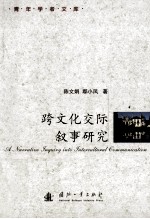

跨文化交际叙事研究PDF电子书下载
- 电子书积分:13 积分如何计算积分?
- 作 者:陈文娟,鄢小凤著
- 出 版 社:北京:国防工业出版社
- 出版年份:2012
- ISBN:9787118080001
- 页数:388 页
CHAPTER 1 THE IMPORTANCE AND HISTORY OF INTERCULTURAL COMMUNICATION 1
1.1 The Nature of Intercultural Communication 2
1.1.1 Defining Intercultural Communication 2
1.1.2 The Problem of Cultural Difference and Cultural Sensitivity 3
1.2 The Importance of Intercultural Communication 8
1.2.1 New Technology and Information Systems 12
1.2.2 Changes in the World Population 14
1.2.3 Economic Globalization 19
1.2.4 Development of Multiculturalism 23
1.3 An Overview of Intercultural Communication 29
1.3.1 The Development of Intercultural Communication in the West 30
1.3.2 The Contents of Intercultural Communication Study 36
1.3.3 Intercultural Communication Research Situation in China 60
1.4 The Significance of Intercultural Communication Research 65
Questions for Discussion 66
References 66
CHAPTER 2 CULTUURE AND COMMUNICATION 73
2.1 Culture 73
2.1.1 The Essence of Culture 76
2.1.2 Defining Culture 78
2.1.3 Layers of Culture 85
2.1.4 The Elements of Culture 90
2.1.5 The Basic Functions of Culture 92
2.1.6 The Characteristics of Culture 93
2.2 Communication 100
2.2.1 The Essence of Communication 102
2.2.2 Defining Communication 102
2.2.3 Types of Communication 106
2.2.4 Characteristics of Communication 108
2.2.5 Means of Communication 111
2.2.6 A Major Issue in Communicatiorr—Stereotyping 112
2.3 The Relationship between Culture and Communication 118
Questions for Discussion 120
References 120
CHAPTER 3 LANGUAGE AND CULTURE 124
3.1 Language and Communication 124
3.1.1 The Importance of Language in Intercultural Communication 124
3.1.2 The Components of Language 134
3.1.3 Characteristics of Language 142
3.1.4 Functions of Language 147
3.1.5 Changes in Language 152
3.2 Language,Culture,and Thought Processing 157
3.2.1 Linguistic Determinism/Sapir-Whorf Hypothesis 159
3.2.2 Language and Cultural Attachment 171
3.2.3 Culture and the Rules of Interaction 175
3.2.4 Culture and Meaning of Words 180
3.3 Language Varieties 183
3.3.1 Pidgin 183
3.3.2 Creole 184
3.3.3 Regional Dialect 184
3.3.4 Minority Dialect 184
3.3.5 Indigenized Variety 185
3.3.6 World Englishes 186
3.4 Gender and Language 196
3.4.1 Gender and Gender Stereotypes 197
3.4.2 Family Influence on Boys and Girls' Communication Manners 199
3.4.3 Gender Differences in Communication 201
3.4.4 Gender and Intercultural Communication 206
Questions for Discussion 208
References 208
CHAPTER 4 NONVERBAL COMMUNICATION AND CULTURE 214
4.1 The Importance of Nonverbal Communication in Intercultural Communication 215
4.2 The Relationship between Nonverbal Communication and Culture 222
4.2.1 Nonverbal Communication Is Culture Bound 222
4.2.2 What Nonverbal Behavior Communicates 224
4.2.3 Larger Cultural Patterns Reflected in the Nonverbal Behavior 224
4.3 Defining Nonverbal Communication 226
4.3.1 Origin 226
4.3.2 Definition 227
4.4 Functions of Nonverbal Communication 228
4.5 Classifications of Nonverbal Communication 230
4.5.1 Kinesics 230
4.5.2 Haptics:Touching in Communication 243
4.5.3 Appearance and Dress 247
4.5.4 Olfactics 250
4.5.5 Oculesics 251
4.5.6 Paralanguage 253
4.5.7 Proxemics 256
4.5.8 Chronemics 261
4.5.9 Silence 268
Questions for Discussion 270
References 271
CHAPTER 5 IDENTITY AND VALUES 274
5.1 Identity 274
5.1.1 The Need to Understand Identity 274
5.1.2 Classification of Identity 277
5.1.3 Immigration and Displacement 282
5.1.4 Identity Crisis and Identity Reconstruction 286
5.2 Values 296
5.2.1 What Is Value 297
5.2.2 Different Values and Misunderstandings 301
Questions for Discussion 332
References 333
CHAPTER 6 INTERCULTURAL COMMUNICATION AND INTERCULTURAL EDUCATION/MULTICULTURAL EDUCATION 336
6.1 Introduction 336
6.2 Culture,Diversity,and Education 340
6.2.1 Culture 340
6.2.2 Diversity 341
6.2.3 The Abandonment of Assimilation Model and the Rise of the Multiculturalism Model 342
6.3 The Nature of Intercultural Education/Multicultural Education 346
6.4 Barriers to Multiculturalism 352
6.4.1 Whiteness 352
6.4.2 Cultural Elitism 353
6.5 Present Situation for Minority Students in Multicultural Classroom 355
6.5.1 Chinese Immigrant Children in Canada 357
6.5.2 Latin and African American Students 360
6.5.3 Muslim Students 362
6.6 Teaching in a Multicultural Classroom 363
6.6.1 Challenges Faced by Teachers in the New Century 363
6.6.2 Teachers'Role in a Multicultural Classroom 365
6.7 Dilemma for Internationally Educated Professionals 370
6.8 Intercultural Education in China 376
6.9 Intercultural Education in Business 380
Questions for Discussion 381
References 382
- 《红色旅游的社会效应研究》吴春焕著 2019
- 《汉语词汇知识与习得研究》邢红兵主编 2019
- 《生物质甘油共气化制氢基础研究》赵丽霞 2019
- 《东北民歌文化研究及艺术探析》(中国)杨清波 2019
- 《联吡啶基钌光敏染料的结构与性能的理论研究》李明霞 2019
- 《异质性条件下技术创新最优市场结构研究 以中国高技术产业为例》千慧雄 2019
- 《《国语》和《战国策》词汇比较研究》陈长书著 2017
- 《中国制造业绿色供应链发展研究报告》中国电子信息产业发展研究院 2019
- 《行政保留研究》门中敬著 2019
- 《新课标背景下英语教学理论与教学活动研究》应丽君 2018
- 《中风偏瘫 脑萎缩 痴呆 最新治疗原则与方法》孙作东著 2004
- 《水面舰艇编队作战运筹分析》谭安胜著 2009
- 《王蒙文集 新版 35 评点《红楼梦》 上》王蒙著 2020
- 《TED说话的力量 世界优秀演讲者的口才秘诀》(坦桑)阿卡什·P.卡里亚著 2019
- 《燕堂夜话》蒋忠和著 2019
- 《经久》静水边著 2019
- 《魔法销售台词》(美)埃尔默·惠勒著 2019
- 《微表情密码》(波)卡西亚·韦佐夫斯基,(波)帕特里克·韦佐夫斯基著 2019
- 《看书琐记与作文秘诀》鲁迅著 2019
- 《酒国》莫言著 2019
- 《指向核心素养 北京十一学校名师教学设计 英语 七年级 上 配人教版》周志英总主编 2019
- 《北京生态环境保护》《北京环境保护丛书》编委会编著 2018
- 《指向核心素养 北京十一学校名师教学设计 英语 九年级 上 配人教版》周志英总主编 2019
- 《抗战三部曲 国防诗歌集》蒲风著 1937
- 《高等院校旅游专业系列教材 旅游企业岗位培训系列教材 新编北京导游英语》杨昆,鄢莉,谭明华 2019
- 《中国十大出版家》王震,贺越明著 1991
- 《近代民营出版机构的英语函授教育 以“商务、中华、开明”函授学校为个案 1915年-1946年版》丁伟 2017
- 《新工业时代 世界级工业家张毓强和他的“新石头记”》秦朔 2019
- 《智能制造高技能人才培养规划丛书 ABB工业机器人虚拟仿真教程》(中国)工控帮教研组 2019
- 《陶瓷工业节能减排技术丛书 陶瓷工业节能减排与污染综合治理》罗民华著 2017
